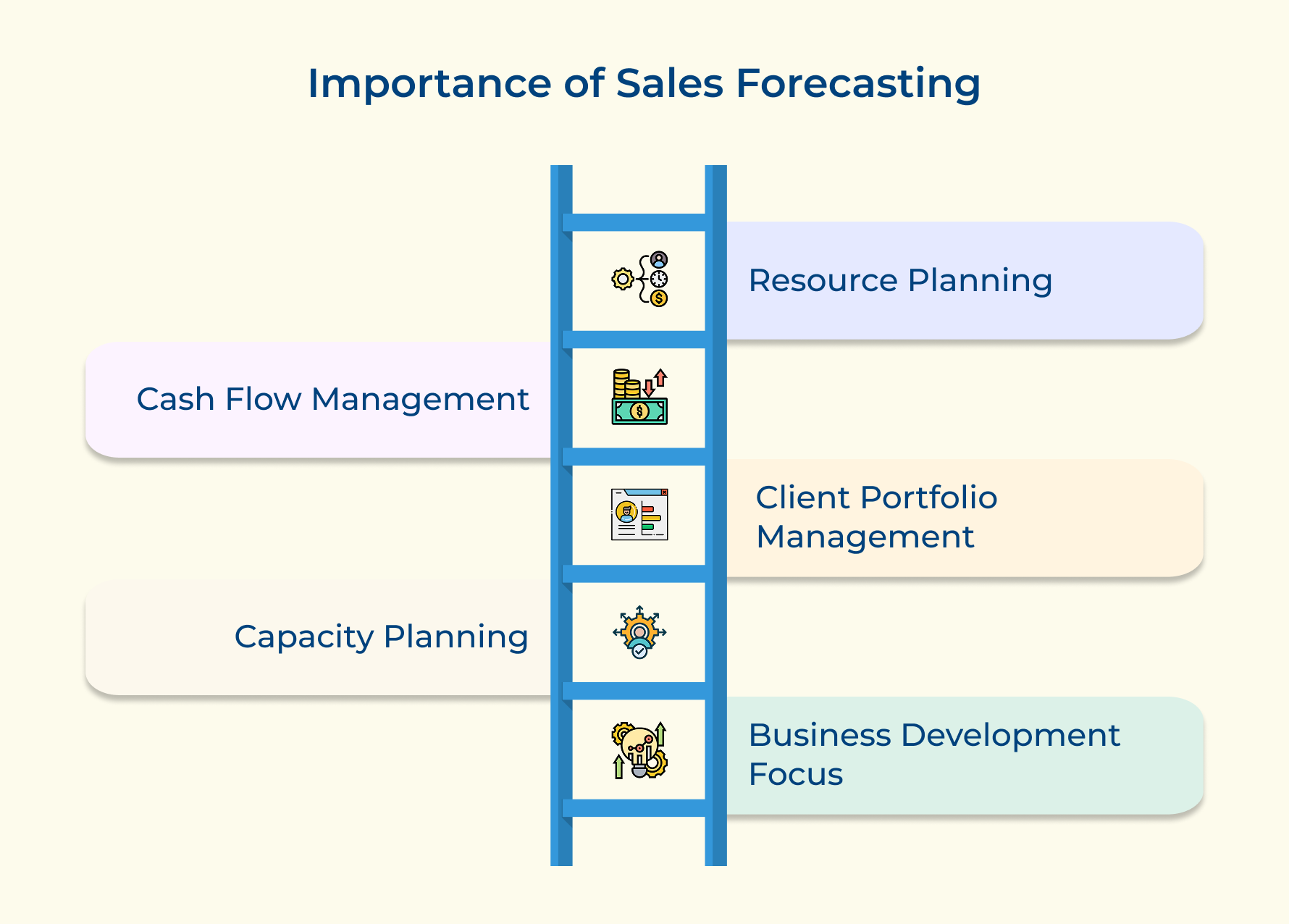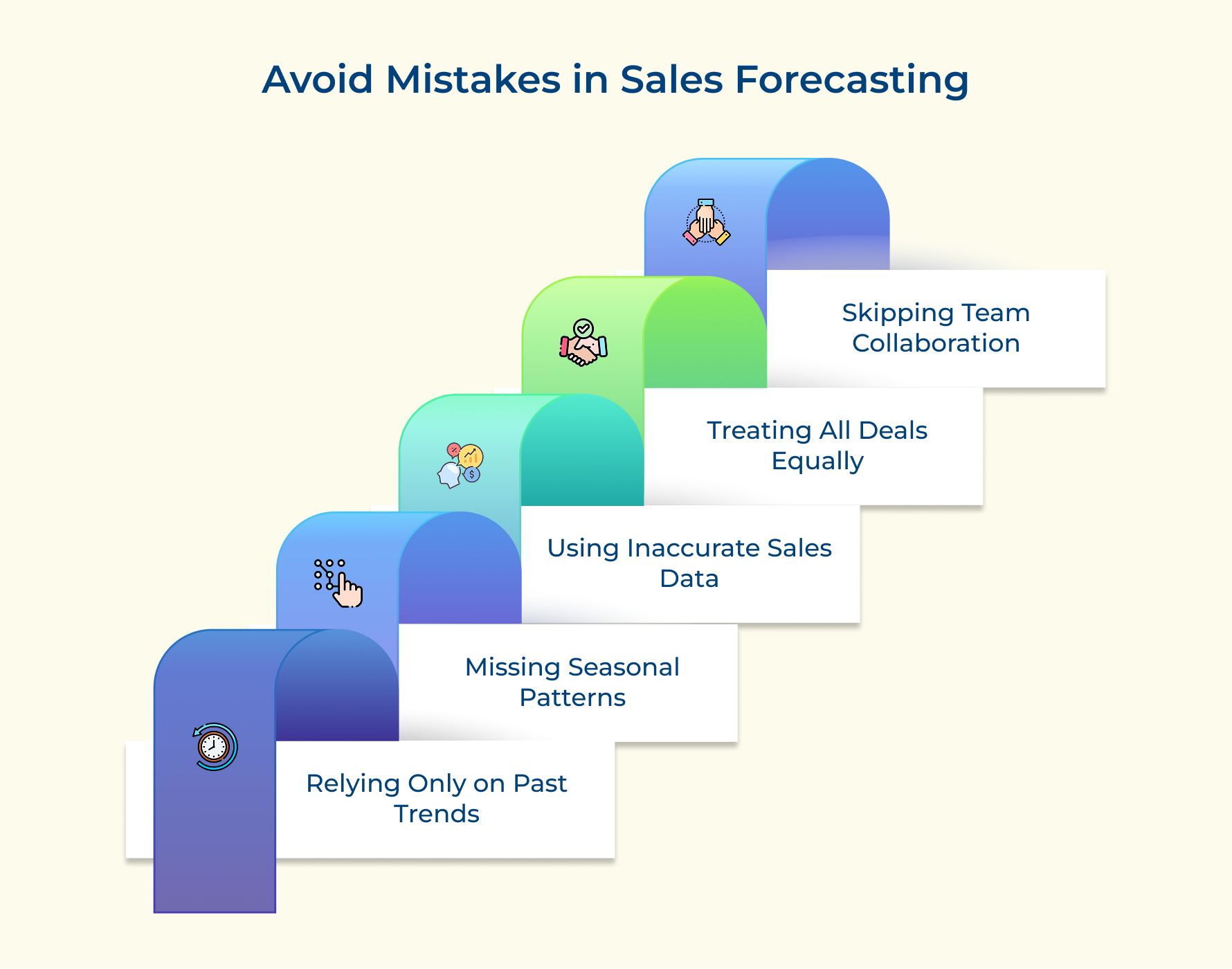How to Create Accurate Sales Forecasting in 10 Easy Steps

Key Highlights:
- Sales forecasting optimizes resource allocation, cash flow management, and business growth by predicting future sales trends accurately.
- Using historical data, market trends, and technology improves forecasting accuracy, helping businesses stay agile in changing market conditions.
- Regularly monitoring forecasts, involving sales teams. Hence, reducing risks while improving strategic decision-making.
Running a business in the current conditions can feel overwhelming with unpredictable cash flows, misaligned resources, and missed opportunities. It makes revenue forecasting a constant struggle.
Sales teams are left guessing, while leadership makes critical decisions based on gut instinct rather than solid data.
It doesn’t have to be this way. Strategic sales forecasting replaces uncertainty with confidence. Let’s show you how to harness data as well as market insights to create accurate forecasts, and build predictable revenue, all while driving long-term growth.
What is Sales Forecasting?
Sales forecasting is the process of estimating future sales performance by analyzing historical data, market trends, economic indicators, and other relevant factors to predict revenue over a specific time period.
It involves using various analytical methods and tools to make educated predictions about how much of a product or service a business expects to sell in the coming weeks, months, or years.
Accurate forecasting helps organizations optimize inventory management, preventing both stockouts and excess inventory costs. Sales forecasting helps identify potential market opportunities and risks early, giving businesses time to adapt their strategies accordingly.
Key objectives of sales forecasting:
- Resource optimization: Ensure efficient allocation of human, financial, and material resources based on projected demand.
- Risk management: Identify potential market risks and opportunities early to develop appropriate mitigation strategies.
- Performance measurement: Establish realistic sales targets and benchmarks to evaluate the team along with organizational performance.
- Strategic planning: Guide long-term business strategy by providing data-driven insights for expansion, product development, and market entry decisions.
Why is Sales Forecasting Important?
It isn’t just about numbers – the sales forecasting process is about building accurate predictions. How is it important for your business? Let’s explore!
Resource Planning
Sales forecasting ensures teams are properly staffed as well as optimized by anticipating staffing needs and project workloads. It helps prevent understaffing and reduces downtime, maximizing efficiency.
Cash Flow Management
Accurate sales forecasts give a clear picture of future revenue, allowing businesses to manage finances better. The visibility helps with decisions on investments, expenses, and overall cash flow.
Client Portfolio Management
Regular forecasts allow businesses to spot growth trends in client accounts. It means service teams can focus on areas that need attention and nurture promising opportunities.
Capacity Planning
Businesses can make informed decisions on hiring, training, and expanding service offerings. This ensures the team’s skills and resources align with future demands.
Business Development Focus
Opportunity stage forecasting helps sales teams target the right possibilities, focusing on industries or service areas with the most growth potential, and driving strategic business expansion.
How to Create Accurate Sales Forecasting?
Reliable sales forecasting methods can drive steady growth and prevent constant uncertainty. Let’s break down the steps to build a sales forecast you can trust.
1. Gather Historical Data
Looking at past sales data helps you get a sense of what to expect. Say you run an online clothing store and notice sales spike every November for winter coats. That trend helps you stock up in advance, ensuring you don’t run out when demand is high.
Historical data reveals patterns, like seasonal surges or slow periods, helping businesses prepare smarter. By analyzing past trends, you can set realistic sales goals as well as optimize inventory. You can also adjust marketing efforts to match buying behaviors, making future sales more predictable and profitable.
Tips:
- Regularly clean and update your sales data to ensure accuracy, removing outliers or irrelevant entries.
- Use data from different time frames to identify seasonal, cyclical, or long-term patterns and trends.
2. Identify Key Factors Influencing Sales
Key factors influencing sales include,
- Internal factors like marketing strategies, product changes, etc and
- External factors such as economic conditions, competitor actions, and customer preferences.
These factors can significantly affect sales performance and help provide context to raw sales data. Understanding what drives sales, such as market fluctuations or a new marketing campaign, ensures more accurate and realistic forecasts.
Regularly track external events like changes in the economy or industry to understand their potential impact on sales. Factor in customer preferences as well as competitor strategies when forecasting, adjusting for these variables to produce a more refined and realistic forecast.
Tips:
- Conduct regular market research to stay updated on external factors like economic shifts and customer behavior.
- Integrate competitor analysis into your forecasting model to anticipate shifts in the market and adjust sales strategies accordingly.
3. Choose the Right Forecasting Model
Picking the right forecasting model is key to making accurate predictions. Here’s a breakdown of the most common models and when to use them:
Time-Series Analysis – Best for stable sales patterns.
- Ideal for retail businesses with consistent seasonal trends.
- Helps predict future sales based on past performance.
Regression Models – Useful for spotting relationships between variables.
- Example: How does marketing spend impact sales?
- Great for businesses looking to understand influencing factors.
Machine Learning Models – Best for complex data analysis.
- Identifies hidden patterns in large datasets.
- Useful for businesses with multiple sales drivers.
Choosing the right model ensures accurate forecasts, smarter planning, and better business
Tips:
- Test different models using historical data and compare results to determine which model yields the most accurate results.
- Regularly assess your forecasting model’s accuracy and update it as your business or market conditions evolve.
4. Incorporate Input from Sales Teams
Your sales team is on the front lines, talking to customers daily. Their insights add a real-world perspective that data alone can’t provide. Here’s why their input is crucial:
Customer Trends & Sentiment
- Sales reps notice shifts in customer behavior before they show up in reports.
- They can highlight changes in demand or emerging pain points.
Competitor Insights
- They hear about competitor moves firsthand—pricing changes, new offerings, etc.
- Helps you adjust strategies proactively.
Real-Time Market Feedback
- They know which deals are close to closing and which might stall.
- This makes forecasts more accurate and realistic.
Regular check-ins with your sales team ensure you’re not just relying on numbers—you’re making informed, dynamic predictions!
Tips:
- Hold weekly or monthly meetings with your sales team to discuss key customer feedback and emerging market trends.
- Set up a system where sales reps can easily submit updates or changes that could impact forecasts.
5. Segment Sales Data
Sales segmentation means breaking down your sales data into smaller groups like product types, regions, customer demographics, or sales channels. You get to see patterns that might be hidden in overall numbers. Analyze each segment separately to spot growth opportunities and potential challenges early.
For example, if a particular product is selling well in one region but not in another, you can adjust your strategy accordingly. A targeted approach makes forecasting more accurate and helps allocate resources more effectively, ensuring your business focuses on the right areas for improvement.
Tips:
- Create segmented forecasts based on product categories, customer types, or regions for clearer insights.
- Regularly review performance within each segment and adjust forecasts as needed to reflect changes in demand.
6. Account for Seasonality
Seasonality refers to predictable changes in sales volume at certain times of the year, such as holidays, weather changes, or annual events. Recognizing and accounting for these fluctuations is essential for accurate forecasting.
Failure to account for seasonality can result in over- or underestimation of sales during certain periods. Seasonality is often a significant factor in forecasting, especially for retail or seasonal businesses, and should be integrated into all forecasts.
Adjust sales predictions based on historical data from similar seasons in previous years. For example, if your business typically sees a spike in sales during the holiday season, reflect this increase in your forecast to ensure proper inventory and staffing levels.
Tips:
- Analyze past sales data for seasonal peaks and troughs, adjusting forecasts accordingly.
- Create separate forecasts for peak and off-peak seasons, adjusting resources as well as strategies for each period.
7. Use Technology and Tools
Technology makes sales forecasting smarter and easier by automating data collection, analyzing trends, while also improving accuracy. Regardless of whether it is a simple spreadsheet or an AI-powered system, the right tools help process large amounts of data quickly.
You can adjust forecasts as new trends emerge, keeping your predictions reliable with real-time insights. Using CRM software or forecasting tools saves time and reduces guesswork.
Machine learning can even spot hidden patterns in complex data, helping you make better business decisions. The right tech takes the stress out of forecasting and helps you stay ahead of the competition.
Tips:
- Invest in a robust forecasting tool that fits your company’s needs and budget.
- Ensure your forecasting software integrates well with your sales, inventory, and CRM systems for seamless data flow.
8. Monitor and Compare
Keeping an eye on your sales forecasts isn’t just a one-time task—it’s an ongoing process. Regular tracking helps you spot gaps, refine predictions, and stay on target.
- Track Actual vs. Forecasted Sales
Keep an eye on your actual sales numbers and compare them to your forecasts. This helps you see where predictions were spot on—or way off. - Spot Trends & Adjust Early
Regular monitoring lets you catch issues before they become major problems. If sales aren’t matching projections, tweak your strategy in real-time. - Use Dashboards for Real-Time Insights
Set up live dashboards to visualize sales performance. If numbers fluctuate, dig into the reasons—market shifts, sales gaps—and refine your next forecast for better accuracy.
Tips:
- Set up regular checkpoints (e.g., weekly or monthly) to review sales data and compare it with your forecasts.
- Create a reporting system that highlights significant variances between actual sales and forecasts for quicker action.
9. Refine Your Forecasting Process
Refining the forecasting process means consistently improving your methods based on performance results, feedback, and new data. It involves learning from past forecasts to enhance future predictions.
Sales forecasting is dynamic. The market, customer behavior, and business operations change, so regularly refining your process ensures that forecasts remain relevant as these factors evolve.
Analyze past forecasts to identify areas of improvement. Incorporate new methods or data sources, and regularly review your forecasting techniques to ensure that they reflect changes in your business environment.
Tips:
- After each forecast cycle, perform a post-mortem analysis to understand forecasting errors and improve methods.
- Experiment with new forecasting techniques or tools and assess their effectiveness through performance reviews.
10. Maintain Flexibility
Sales forecasting needs to be flexible. Market trends, economic shifts, and unexpected events can impact sales, so being adaptable is key. Instead of sticking to rigid projections, regularly update forecasts based on new data and insights.
Businesses get to stay agile, make informed decisions, and avoid major disruptions. Facing a sudden change in demand or a shift in customer behavior? Having a process to adjust forecasts ensures you’re always prepared.
Tips:
- Establish a process to review and revise forecasts on a quarterly or monthly basis.
- Keep key stakeholders informed of any forecast changes and how they might impact overall business strategies.
Common Sales Forecasting Mistakes
Even the best sales forecasts can go off track if common mistakes aren’t avoided. Recognizing these pitfalls helps improve accuracy and drive better decisions.
Over-reliance on Historical Data
Many businesses rely too much on past sales trends, ignoring market shifts, emerging competitors, or changing customer behaviors.
To fix this, use a mix of historical data and forward-looking insights. Incorporate real-time market trends, customer sentiment, and competitor analysis. Regularly update assumptions and adjust forecasts to reflect current realities. Implement a trend-monitoring system to detect early market shifts.
Ignoring Seasonality and Cyclical Patterns
Failing to account for seasonal demand fluctuations can lead to overestimations or missed opportunities.
Address this by analyzing multiple years of data to identify patterns. Develop seasonality indices to adjust forecasts for peak and slow seasons. Track unusual events that might distort trends and factor them into your calculations.
Poor Data Quality Management
Inaccurate, incomplete, or outdated data weakens forecasting accuracy.
To resolve this, implement strict data entry protocols and validation processes. Automate data quality checks, conduct regular audits and enforce strong data governance. Train sales teams on proper data entry, use standardized input forms and keep sales databases updated.
Neglecting Pipeline Quality Assessment
Not all pipeline opportunities carry the same probability, yet businesses often treat them equally.
Solution: Introduce a structured pipeline qualification process with clear deal probability criteria. Train sales teams to assess deal quality accurately, update opportunity stages regularly, and use weighted pipeline values in forecasts. Hold frequent pipeline review meetings to validate opportunities.
Inadequate Stakeholder Involvement
Forecasts created in isolation without input from key teams lead to inaccurate insights and low adoption.
Fix this by fostering a collaborative forecasting approach. Involve sales, marketing, operations, and finance teams. Schedule regular forecast review meetings, establish clear communication channels, and ensure all stakeholders understand their role in the process.
Unlocking Business Potential with Sales Forecasting
Sales forecasting is essential for businesses aiming to plan effectively and create growth. Accurate sales predictions enable companies to make informed decisions, allocate resources efficiently, and reduce risks.
With the rise of advanced analytics and AI, forecasting accuracy has significantly improved. Businesses can now adapt to market changes more quickly, staying ahead of potential challenges and opportunities.
Using these insights, companies can enhance operational efficiency, improve customer satisfaction, and maintain a competitive edge. Ultimately, effective sales forecasting contributes to long-term success and profitability.
Limit time — not creativity
Everything you need for customer support, marketing & sales.
Neeti Singh is a passionate content writer at Kooper, where he transforms complex concepts into clear, engaging and actionable content. With a keen eye for detail and a love for technology, Tushar Joshi crafts blog posts, guides and articles that help readers navigate the fast-evolving world of software solutions.


